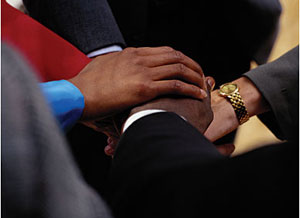
|
There is a lot of talk about leadership development but very little specific leadership skill training is available.
It seems like success is dependent upon surrounding yourself with the right people and hoping they have the skills necessary to do the job. Compassion often prevents us from replacing in a timely fashion those who don’t have the skills, while very little coaching and mentoring support is available within the company.
This is a sad commentary considering team-building and teamwork skills are critical to the effectiveness of the management team. Success of your management team can be defined by what is accomplished as a group. You need a synergy within the team that creates unity and clarity of direction with a common purpose that is in alignment with strategic initiatives. This is the first prerequisite for your management team to be effective.
Clarity of goals
A common purpose and crystal clarity of goals and objectives are essential. Team-building exercises must support the development of this clarity, which includes responsibilities and accountability.
“Purpose is the driving force of all accomplishments of greatness.” — Thomas Carlyle
What is your management team’s real purpose? Do all members of the team share the same response to that question? Is it crystal clear to all? Leaders must gain the support of many people to meet or exceed established objectives. This means they must develop or possess a unique understanding of people. The ability to coach-mentor and teach leadership skills to others is the driving force that will create a winning organization. It is the driving force that can bring those employees who are outliers and those skeptical of management into a team environment.
Team dysfunction
I recently conducted three different workshops utilizing Patrick Lencioni’s “Five Dysfunctions of a Team” book. Doing these workshops was very
eye-opening because each team member revealed personal characteristics and life incidents that helped form their personal values. Lencioni’s work focuses on five dysfunctions that limit the effectiveness and results any team can accomplish. Each dysfunction builds on itself, making it extremely difficult to maximize team effectiveness. Lencioni identifies these dysfunctions as:
- Absence of trust
- Fear of conflict
- Lack of commitment
- Avoidance of accountability
- Inattention to results
My workshops went to the very heart of why teams, even the best ones, often struggle. Lencioni’s material outlines a powerful model and actionable steps that can be used to overcome these common hurdles and build a cohesive, effective team.
Communication
This topic is discussed in every management book written because ineffective communication is generally at least partially responsible for the majority of failures within any management team. The key to effective communication starts with being able to listen effectively. In addition to listening skills, an effective management team must foster trust within the group, respect for each other and their abilities, an open honesty to be able to express opinions without fear and a feeling of camaraderie that breeds an atmosphere of sharing both credit for success and responsibility for failure. In other words, a common purpose.
Trust and respect
The achievement of trust and respect enables your management team to reach deep down and give its all despite difficult circumstances. To be effective and trustworthy, a manager has to be willing to admit where he/she has failed and identify his/her imperfections as personal-development areas. Admitting and identifying such issues regarding one’s self further fosters trust and respect. It demonstrates to teammates you are human and you don’t have all the answers.
Set ego aside
We all have egos but leaders with a common purpose control their own egos and understand how to utilize their understanding of people to inspire peak performance. They are confident and have high self-esteem without demonstrating arrogance. They are not only compassionate but passionate about success and make every effort to create an effective management team. They have the unique ability to communicate and demonstrate exceptional listening skills.
It’s your responsibility
Solving team dysfunction by creating a common purpose and an effective management team is a primary responsibility of leadership. Understanding the team you have put in place to help you run the business is not a luxury. It is a responsibility you must accept as a leader. Every one of us is a human being with different values, different beliefs, different backgrounds and different views. Ask yourself, “How can you possibly create a common purpose without a complete understanding of every team member?”
Follow these 10 tips to create a common purpose for your team.
- Create an intentional communication strategy. Your management team must understand and support a common vision with a common purpose. This requires clarity. Clarity begins with effective communication. Make sure communication from your management team reaches all employees.
- Do not set up intentional competition in the workplace. Try to ensure individual skill sets complement rather than compete with one another. Spread the responsibility and authority around by alternating leaders for various tasks. Look for star potential and introduce coaching and mentoring as a skill set.
- Create team ownership in the decision-making process; but it’s not management by committee. Avoid group think by making sure individuals express opinions openly without intimidation. Responsibility must be accompanied by authority and accountability.
- Build trust and respect by giving trust and respect. Act as a coach or mentor and not a boss.
- Create offsite team-building activities on a quarterly basis. The gatherings/outings should be used to build unification and trust in each other.
- Don’t just talk about empowerment and delegation, believe in it and demonstrate that belief by allowing the team members to make decisions and take independent action.
- Take complex plans and strategies and assign accountability and ownership. This creates more efficiency and leverages creativity. Assign responsibility according to individual passions.
- Brainstorming must be encouraged to release team innovation. Bouncing ideas off one another stimulates creative thinking which leads to creative solutions. This bonds individuals into a common purpose.
- Ask for solutions, assigning both responsibility and empowerment. Ownership of ideas and initiatives builds commitment. Involving the team in creating direction and solutions through empowerment generates commitment to the tasks necessary to meet objectives.
- Challenge your management team. Reliance on team effectiveness minimizes risk by being more flexible and adaptive than relying on a single individual. No one individual alone can jeopardize success. The loss of one team member can be overcome without losing sight of the objectives.
A leader has to win the hearts and minds of his management team to create a common purpose. This doesn’t happen by accident. It depends on values and beliefs that create the foundation for how the team works together. It is imperative the leader understands these values and beliefs. They may be unspoken and linger at the subconscious level, but they do affect individual attitudes. That is where the leader’s communication skills become critical.




